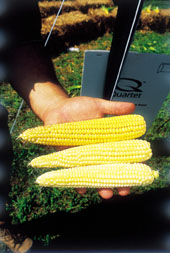
Features
Agronomy
Plant Breeding
Bayfield’s unprecedented success
Variety is tribute to public breeding program.
November 12, 2007 By Ralph Pearce
 Success can be defined by many things. In a soybean variety, success can be
Success can be defined by many things. In a soybean variety, success can be
defined by consistency in yield, popularity among growers and perhaps by its
longevity. A variety can boast of one or two of these traits, but not all three.
Then came OAC Bayfield, a winner on all three fronts.
For the University of Guelph's breeding program, the long-standing success
for OAC Bayfield represents a testament to the public system, not to mention
an unprecedented achievement. At a gala in Guelph, Ontario, in September 2003,
industry stakeholders and researchers gathered to pay tribute to its past and
present developers, and briefly address its future.
First developed in 1985 through the collaborative efforts of Dr. Jack Tanner
and Dr. Wally Beversdorf, the variety underwent eight years of performance trials
and regulatory process before being registered and released through SeCan Association.
Since then, OAC Bayfield has become the touchstone of the public breeding sector.
It has enjoyed a stable hold in the market and has lead to further work in developing
several progeny from the parent lines, with a second generation due in the next
five years.
Dr. Clarence Swanton, a professor and researcher at the University of Guelph,
emceed the anniversary celebration. He thanked the many researchers and graduate
students involved in bringing Bayfield to growers, and those who have maintained
its standing since.
At its peak in 1997, says Swanton, Bayfield covered an estimated 400,000 of
the two million acres of soybeans in Ontario, and in spite of the number of
choices currently available to growers, remains popular to many. "It's
a unique piece of germplasm," says Swanton, adding it has outlasted its
competitors, most of which last two to three years at best. "But OAC Bayfield
has remained one of the top soybean varieties in Ontario and continues to hold
market share. It thrived before genetically modified issues arose with the Europeans,
then claimed a non-GMO export niche thereafter."
Well suited to many conditions
Initially developed for the 2650 heat unit area, Bayfield was incorrectly assigned
under the 2700 to 2900 heat unit varieties in 1994, yet managed to achieve a
yield index of 106 percent. The next year the variety was correctly placed on
the recommended list, coming in at 115 percent yield index. "It's an important
triumph for public breeding programs that we are successful," says Swanton,
calling Bayfield a significant win for so many different people. "It's
a demonstration of the science that we have in the province to deliver such
technology and it's a demonstration of the training of the people that we can
bring forward to continue to contribute to Ontario agriculture."
From an industry perspective, Bayfield's enduring quality has made it popular
in domestic and international buyers. A higher protein level makes it popular
to the food-grade markets while its high oil content makes it suitable for crushing
purposes. In Japan, buyers like it for its size and similarities to Asian soybeans,
not to mention its suitability for use in tofu and soy milk. In Europe, Bayfield
has found its place in more-westernized fare such as yogurts and flavoured beverages.
According to Wendy Jahn, general manager of the Ontario Soybean Growers, Bayfield's
diversity and durability have been impossible to ignore. "There's only
a handful of varieties that were released at the same time that are around today,
and none of them continue to perform against the new genetics that are available,"
she notes. "It's a really good example of the importance of the public
breeding system and how important it's been to Ontario soybean growers."
Public breeding helps growers
If for no other purpose, the public breeding system needs to continue for the
sake of providing growers with a viable alternative, and Jahn compliments everyone
involved in the process of commercializing Bayfield.
"Our growers need access to the best genetics so they can remain competitive
in a world market," she says, noting the importance of having such genetics
at an affordable price. But she also highlights the difference between public
and private programs, citing the former's strength as having an eye on research
and trait development which may not have an immediate payback as part of the
package. "It gives researchers the opportunity to look at the long-term
benefits, and to look at niche markets that don't command a huge acreage, something
a large company may not be able to do."
As for Bayfield's future, it is bright on one hand, yet limited. When it was
developed in 1993, Bayfield's competition numbered in the tens. Now, farmers
can choose from more than 150 varieties, and combined with market trends and
changing technology, the odds are slim for any progeny of Bayfield to become
available and replace it in terms of popularity.
However, Dr. Gary Ablett looks to the future and speaks of Bayfield's 'other'
use: as a parent. In an informal survey, Ablett found 15 to 20 direct descendants
of OAC Bayfield that are in the process of being commercialized. Two of those,
OAC Champion and OAC Kent are what he calls 'truly remarkable', and expects
grandchildren of Bayfield also will be available soon.
"Given the longevity, I would think it's entirely probable that in the
next three or four years, we'll see Bayfield, the children of Bayfield and we'll
see the grandchildren of Bayfield, all on the recommended list and all at the
same time," predicts Ablett, chair of the Plant Agriculture Department
at the University of Guelph. "And I have to think that's really unprecedented."